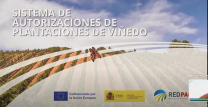Media library
Documentary, graphic and/or audiovisual knowledge objects are offered here, offering information on various sectors and topics. Use the keyword search or search filters to access current audiovisual and documentary knowledge objects useful for your implementation.
If you have any questions or suggestions, please contact us here.
Golden flavescence of grapevine and its vector Scaphoideus titanus Ball
Golden flavescence, in English “flavescence dorée of grapevine”, is a very serious and destructive disease that affects the vine. It is a disease of bacterial origin, being produced by the phytoplasma Candidatus Phytoplasma vitis, which needs to be transmitted by an almost specific vector called the vine cicada (Scaphoideus titanus Ball)
Fact sheet on Xilella fastidiosa
Who is Xilella, the fearsome plant killer?
Technical information on the apple snail pest in rice
The Pomacea insularum (apple snail) species is found in Spain. First detected in 2009, it has spread throughout the Ebro Delta. This species is considered one of the 100 most harmful invasive species.
National contingency plan Pomacea maculata (= P. insularum) (apple snail)
This document sets out the measures to be taken against gastropod mollusc species of the genus Pomacea, a quarantine pest in Europe, with the aim of preventing their appearance and, if they do appear, acting quickly and effectively, determining their distribution and combating them with the aim of eradicating them.
Phytosanitary bulletin of notices and information
Pollinating insects are vitally important for the proper functioning of crops. Pollination is essential to ensuring the quantity and quality of crops and food production, directly linking wild ecosystems with agricultural production systems.
Plant health, pest sheets: Mhytimna unipuncta
Mhytimna unipuncta is a defoliating caterpillar of meadows and corn, which causes damage of varying intensity, although it is increasingly common in Cantabria and in certain areas can cause some alarm among the population.
“Xylella fastidiosa Conference.” Diseases caused by Xylella fastidiosa and its status worldwide.
On February 12, 2019, a "Seminar on Xylella fastidiosa" was held in the Assembly Hall of the Ministry of Agriculture, Fisheries, and Food. This seminar is part of the measures adopted by the Ministry to disseminate information and raise awareness about the fight against and control of Xylella fastidiosa.
Control of powdery mildew in grapevines
Powdery mildew is a disease caused by an ectoparasitic fungus (Erysiphe necator) that overwinters in buds as mycelium, as well as in the shoots, leaves, and bark of vines, in these cases in the form of perithecae or cleistothecae. The fungus begins to develop at temperatures above 5°C and stops when temperatures exceed 35°C.
Disease Report Manual
Each report provides information regarding the 4 fungal diseases that affect vineyards: downy mildew, powdery mildew, botrytis and blackrot.
Poster on Xylella fastidiosa in the Balearic Islands
Xylella fastidiosa (Wells et al.) is a quarantine phytopathogenic bacterium that has a very wide range of host plants (more than 300 plant species), and can cause serious damage to the most important crops of the Balearic Islands, such as almond, vine, olive, citrus or fig trees, and to numerous species of ornamental plants (rosemary, lavender, polygala and acacia, among others).
Program of actions to transpose the National Contingency Plan for Xylella fastidiosa in the Autonomous Community of Extremadura
Xylella fastidiosa is a bacterium that causes rapid and widespread decline in plants. In the most severe cases, the leaves and branches may dry up and, ultimately, the entire plant may die. In many host species, the presence of the bacteria does not produce any symptoms, making detection extremely difficult. X.
Xylella fastidiosa contingency plan, national program for the implementation of phytosanitary regulations.
This document sets out the measures to be taken against the bacterium Xylella fastidiosa, a priority Union quarantine pest, with the aim of preventing its emergence and, if it does appear, acting quickly and effectively, determining its distribution and implementing eradication measures.
Spodoptera frugiperda Contingency Plan (Smith)
This document sets out the measures to be taken against the fall armyworm, Spodoptera frugiperda (Smith), a priority pest (according to Delegated Regulation (EU) 2019/1702) regulated in the European Union (EU) by Regulation (EU) 2016/2031, Regulation (EU) 2019/2072 and Implementing Decision 2018/638 (EU), with the aim of preventing its appearance, and in the event that it appears, acting quickl
Thaumatotibia leucotreta (Meyrik) Contingency Plan
This document sets out the measures to be adopted against Thaumatotibia leucotreta (codling moth), a pest regulated by the EU as a priority quarantine pest under Implementing Regulation (EU) 2019/2072 and Delegated Regulation (EU) 2019/170.
Popillia japonica (Newman) Contingency Plan
This document sets out the measures to be taken against the Popillia japonica (Newman) insect, a quarantine pest, with the aim of preventing its appearance, and if it does appear, acting quickly and effectively, determining its distribution and combating it in order to try to eradicate it and at all times prevent its spread.
Aleurocanthus spiniferus Contingency Plan (Quaintance)
This document sets out the measures to be taken against the quarantine pest Aleurocanthus spiniferus (Quaintance), with the aim of preventing its appearance and, if it does appear, acting quickly and effectively, determining its distribution and combating it in order to try to eradicate it and prevent its spread at all times.
Control of grapevine mildew
Vine downy mildew (Plasmopara viticola) is a disease caused by the endoparasitic fungus Plasmopara viticola. Under favorable environmental conditions, it can attack all green parts of the vine, causing severe damage and significant crop losses.
Contingency Plan for Golden Flavescence of the grapevine
This document sets out the measures to be taken against Flavescence dorée of grapevine (FD), a Union quarantine pest regulated by Regulation (EU) 2016/2031 and Regulation (EU) 2019/2072, with the aim of preventing its appearance, and, if it does appear, acting quickly and effectively, determining its distribution and combating it in order to prevent its spread and eradicate it.
Phytosanitary alert and information network, field protocol for crop monitoring: grapevine
Field manual for estimating the risk of damage caused by pests and diseases in grape cultivation.




